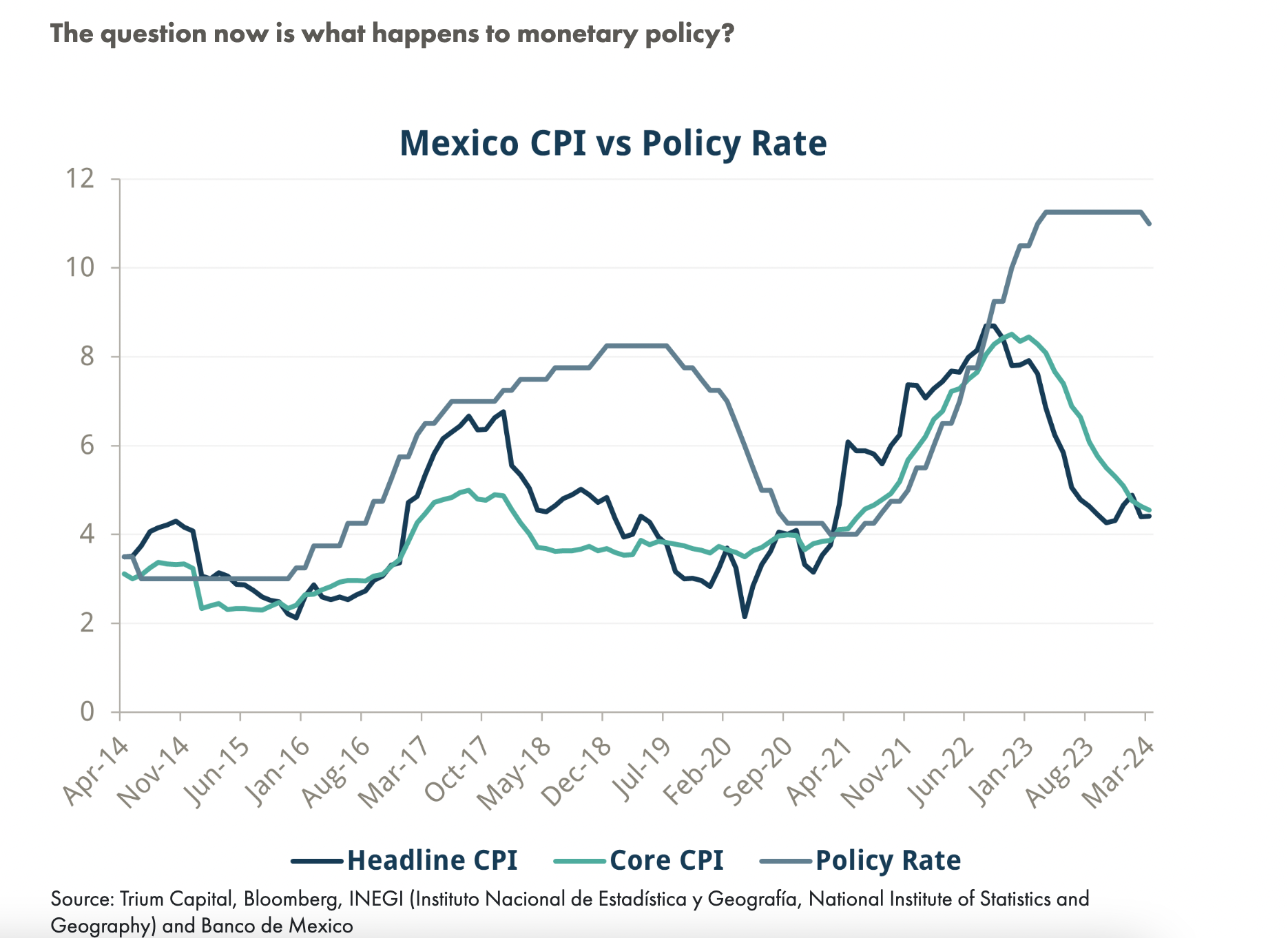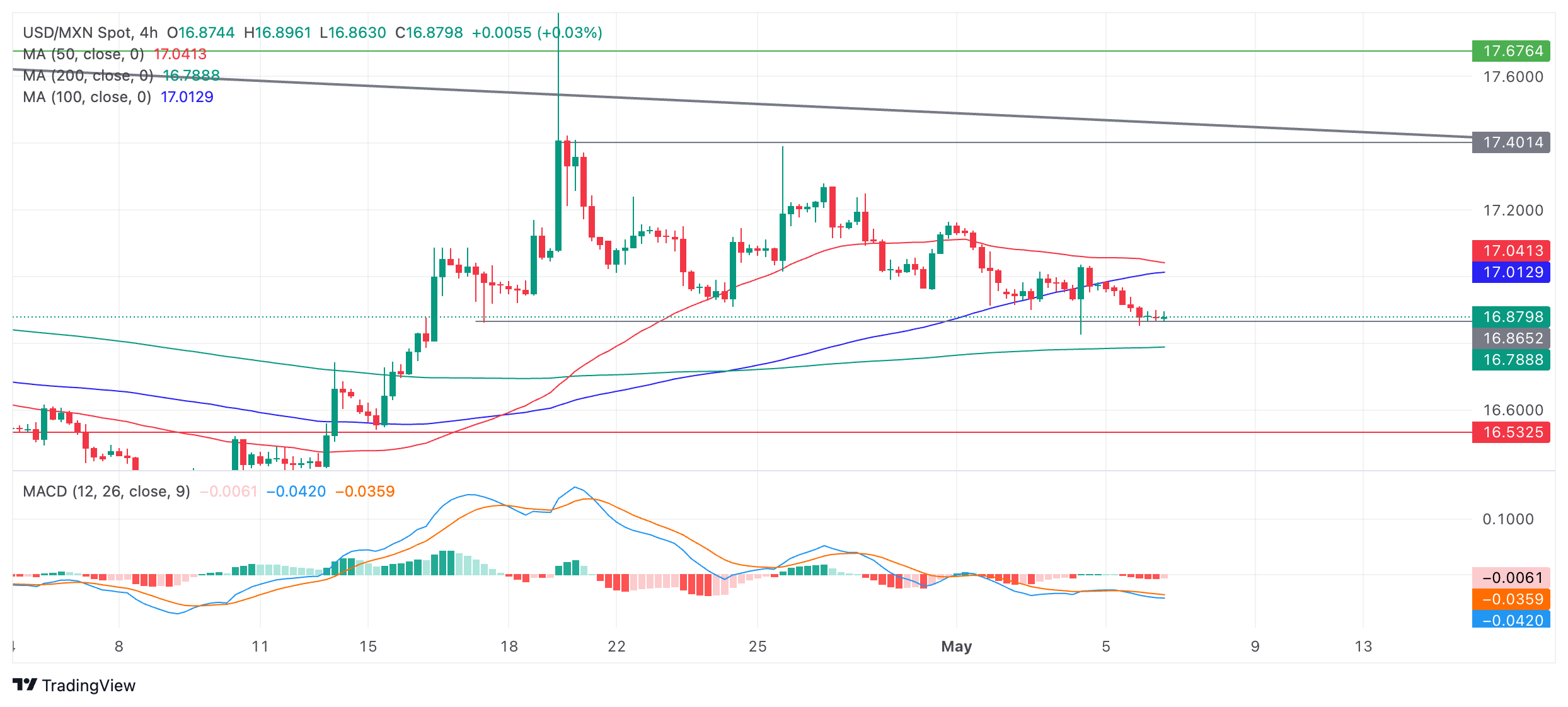- Analiza
- Novosti i instrumenti
- Vesti sa tržišta
- Mexican Peso trades directionless before Banxico meeting
Mexican Peso trades directionless before Banxico meeting
- The Mexican Peso is seesawing between tepid gains and losses ahead of the Banxico meeting on Thursday.
- Mexican April inflation data out on the same day could also cause volatility.
- Analysts at Trium Capital believe there is a higher chance of an interest-rate cut than markets are pricing in.
The Mexican Peso (MXN) fluctuates between tepid gains and losses on Tuesday as many traders wait on the sidelines for key inflation data and the Bank of Mexico (Banxico) policy meeting decision on “super” Thursday.
The positive market sentiment of the last few days, a factor benefiting the risk-sensitive Peso, finally unwinds with Asian stocks rounding out their session broadly lower.
On the geopolitical front, sentiment improves after Hamas agrees to a ceasefire with Israel but then quickly sours on the news Israeli units have moved into the Southern Gazan city of Rafah.
USD/MXN is trading at 16.88, EUR/MXN at 18.16 and GBP/MXN at 21.18, at the time of publication.
Mexican Peso trades with low volatility ahead of key events
The Mexican Peso trades little changed ahead of Mexican April inflation data and the Banxico meeting on Thursday, with both events having the potential to cause volatility for MXN.
Both the headline and core inflation rates are scheduled for release on Thursday at 12:00 GMT. Headline Inflation is expected to show a higher 4.63% reading year-over-year but a slower 0.18% monthly rise.
The core inflation rate is forecast to decline to 4.40% YoY and 0.24% MoM.
If either comes out higher than expected, but especially core inflation – which is thought to be more accurate – the Mexican Peso could gain strength. Higher levels of inflation will force Banxico to keep interest rates at their current elevated levels for longer, and higher interest rates attract greater capital inflows.
Banxico meeting – a surprise cut?
The Banxico will hold its May policy meeting on Thursday at 19:00 GMT. Given the hawkish minutes of the March meeting, the bank’s commitment to a data-dependent approach and the relatively robust economic data of recent months, the consensus expectation is for Banxico to keep the policy rate unchanged at 11.0%.
According to Trium Capital, however, even if Banxico does not make an interest rate cut in May, it probably will soon after. The thrust of their argument is based on two key points. The first is that high interest rates are slowing down the GDP growth rate and economic activity in Mexico substantially.
“The case for cuts is supported by slowing economic activity. The monthly economic activity indicator surprised to the upside for February with 1.38% MoM compared to a 0.50% analyst expectation, but that comes after four consecutive negative prints since October,” says Javier Basabe, an analyst at Trium Capital.
Secondly, the Consumer Price Index (CPI) over the long run has diverged so far away from the Banxico’s policy rate that this is increasing the likelihood of cuts. Additionally, it has pushed bond markets to extremes, making a mean reversion increasingly likely.
“In our opinion, the argument about the hawkish Banxico minutes is misplaced. Could it mean this is not the start of a cycle, and that rates might be held at the May meeting? Sure. Is it all that relevant? We would argue not. This growth slowdown is also happening with a record deficit and very high spending which is projected to be reduced next year, further dampening growth. If Banxico does keep rates on hold in May, there will still be more cuts to come,” says Basabe.
Technical Analysis: USD/MXN on the floor of short-term range
USD/MXN – the cost of one US Dollar in Mexican Pesos – creeps along the bottom of its short-term range. The pair has been oscillating between a floor at 16.86 and a ceiling at 17.40 since the April 19 highs.
USD/MXN 4-hour Chart
The short-term trend is sideways, and given the old trading maxim that the “trend is your friend”, this is expected to continue.
Despite several attempts to break below the range floor, bearish pressure was insufficient and prices recovered back inside the range.
There is an overall bearish backdrop, however, given that the medium and long-term trends are both down and these bigger currents influence the shorter-term perspective.
A rise back up within the range is expected that could take the USD/MXN up to the 50 Simple Moving Average (SMA) on the 4-hour chart at 17.06, followed by the lower high at 17.15. A clear break above the zone of resistance around 17.15-17.18 might see further gains up towards the range highs again.
A decisive breakout of the range – either below the floor at 16.86, or the ceiling at 17.40 – would change the directional bias of the pair.
A break below the floor could see further downside to a target at 16.50, followed by the April 9 low at 16.26.
On the other side, a break above the top would activate an upside target first at 17.67, piercing a long-term trendline and then possibly reaching a further target at around 18.15.
A decisive break would be one characterized by a longer-than-average green or red daily candlestick that pierces above or below the range high or low, and that closes near its high or low for the period; or three green/red candlesticks in a row that pierce above/below the respective levels.
Mexican Peso FAQs
The Mexican Peso (MXN) is the most traded currency among its Latin American peers. Its value is broadly determined by the performance of the Mexican economy, the country’s central bank’s policy, the amount of foreign investment in the country and even the levels of remittances sent by Mexicans who live abroad, particularly in the United States. Geopolitical trends can also move MXN: for example, the process of nearshoring – or the decision by some firms to relocate manufacturing capacity and supply chains closer to their home countries – is also seen as a catalyst for the Mexican currency as the country is considered a key manufacturing hub in the American continent. Another catalyst for MXN is Oil prices as Mexico is a key exporter of the commodity.
The main objective of Mexico’s central bank, also known as Banxico, is to maintain inflation at low and stable levels (at or close to its target of 3%, the midpoint in a tolerance band of between 2% and 4%). To this end, the bank sets an appropriate level of interest rates. When inflation is too high, Banxico will attempt to tame it by raising interest rates, making it more expensive for households and businesses to borrow money, thus cooling demand and the overall economy. Higher interest rates are generally positive for the Mexican Peso (MXN) as they lead to higher yields, making the country a more attractive place for investors. On the contrary, lower interest rates tend to weaken MXN.
Macroeconomic data releases are key to assess the state of the economy and can have an impact on the Mexican Peso (MXN) valuation. A strong Mexican economy, based on high economic growth, low unemployment and high confidence is good for MXN. Not only does it attract more foreign investment but it may encourage the Bank of Mexico (Banxico) to increase interest rates, particularly if this strength comes together with elevated inflation. However, if economic data is weak, MXN is likely to depreciate.
As an emerging-market currency, the Mexican Peso (MXN) tends to strive during risk-on periods, or when investors perceive that broader market risks are low and thus are eager to engage with investments that carry a higher risk. Conversely, MXN tends to weaken at times of market turbulence or economic uncertainty as investors tend to sell higher-risk assets and flee to the more-stable safe havens.
© 2000-2025. Sva prava zaštićena.
Sajt je vlasništvo kompanije Teletrade D.J. LLC 2351 LLC 2022 (Euro House, Richmond Hill Road, Kingstown, VC0100, St. Vincent and the Grenadines).
Svi podaci koji se nalaze na sajtu ne predstavljaju osnovu za donošenje investicionih odluka, već su informativnog karaktera.
The company does not serve or provide services to customers who are residents of the US, Canada, Iran, The Democratic People's Republic of Korea, Yemen and FATF blacklisted countries.
Izvršenje trgovinskih operacija sa finansijskim instrumentima upotrebom marginalne trgovine pruža velike mogućnosti i omogućava investitorima ostvarivanje visokih prihoda. Međutim, takav vid trgovine povezan je sa potencijalno visokim nivoom rizika od gubitka sredstava. Проведение торговых операций на финанcовых рынках c маржинальными финанcовыми инcтрументами открывает широкие возможноcти, и позволяет инвеcторам, готовым пойти на риcк, получать выcокую прибыль, но при этом неcет в cебе потенциально выcокий уровень риcка получения убытков. Iz tog razloga je pre započinjanja trgovine potrebno odlučiti o izboru odgovarajuće investicione strategije, uzimajući u obzir raspoložive resurse.
Upotreba informacija: U slučaju potpunog ili delimičnog preuzimanja i daljeg korišćenja materijala koji se nalazi na sajtu, potrebno je navesti link odgovarajuće stranice na sajtu kompanije TeleTrade-a kao izvora informacija. Upotreba materijala na internetu mora biti praćena hiper linkom do web stranice teletrade.org. Automatski uvoz materijala i informacija sa stranice je zabranjen.
Ako imate bilo kakvih pitanja, obratite nam se pr@teletrade.global.

















